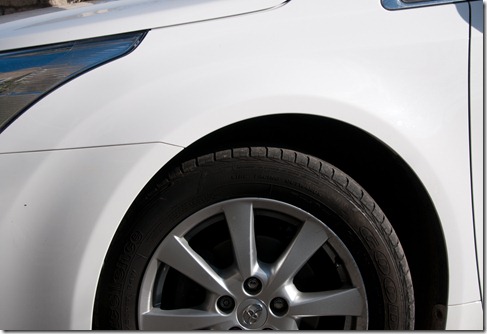For this exercise I tried with white card using shadows under shrubs on a bright winter morning, but I couldn’t get the colour values in Photoshop’s sampler above 242 – this may have been due to the low sun which distorts the pure light, or the makeup of the card itself. I decided to use another source.
Our car is very white and has very dark wheel arches, so this seemed the obvious choice. Maybe not too scientific, but it was worth a try.
There’s some clipping in the reflections on the alloys, but none from the white (a little chipping but no clipping). The white sampled at R249, G248, B249, so a better white than from the card.
The noise reduction on the camera (long exposure and high ISO) was turned off; The ISO was set to 100; Metering was selected to ‘spot’; the shooting mode was ‘aperture priority’.
Having obtained the first exposure, which still had some clipping, I noted the settings and changed the shooting mode to manual. With the noted readings as a starting point, I increased the shutter speed until there was no clipping on the white paint and deleted the previous image. Returning the shooting mode to ‘aperture priority’ I then took spot exposures inside the wheel arch and also on the tyre wall. I kept the aperture setting the same for each reading, to make the EV calculation easier. These were as shown here:
The darkest area measured 6 stops below the white.
Using the Adobe Camera Raw in Photoshop I increased the exposure by 3.85 EV stops until detail in the wheel arch became confused with the noise.
Adding the difference between the darkest and lightest stops to the exposure compensation in Camera Raw, the dynamic range for the camera becomes 6 + 3.85 = 9.85 EV
Looking online at the tests for my camera, more controlled tests show an EV of 12.5. Evidently the lower ISO of 100 is obtained by underexposing the image by 1 stop. This process clips the highlight detail significantly, so better readings are obtained at ISO 200.
Anyway, it’s been a good exercise and I’ve learned some more about my camera. I’ll be using ISO 200 as the norm, unless I want slower shutter speeds than is reasonable at that setting.


No comments:
Post a Comment